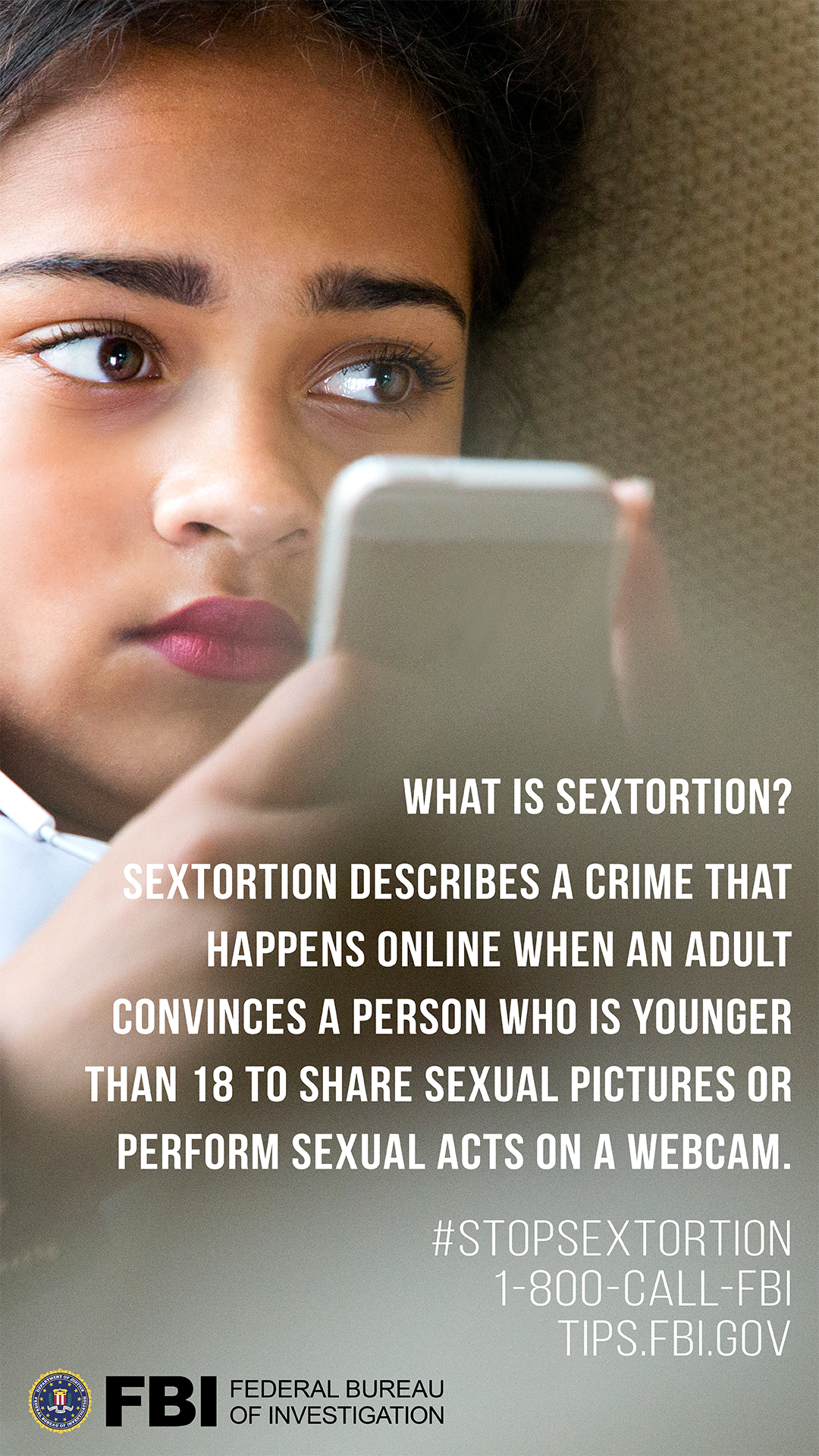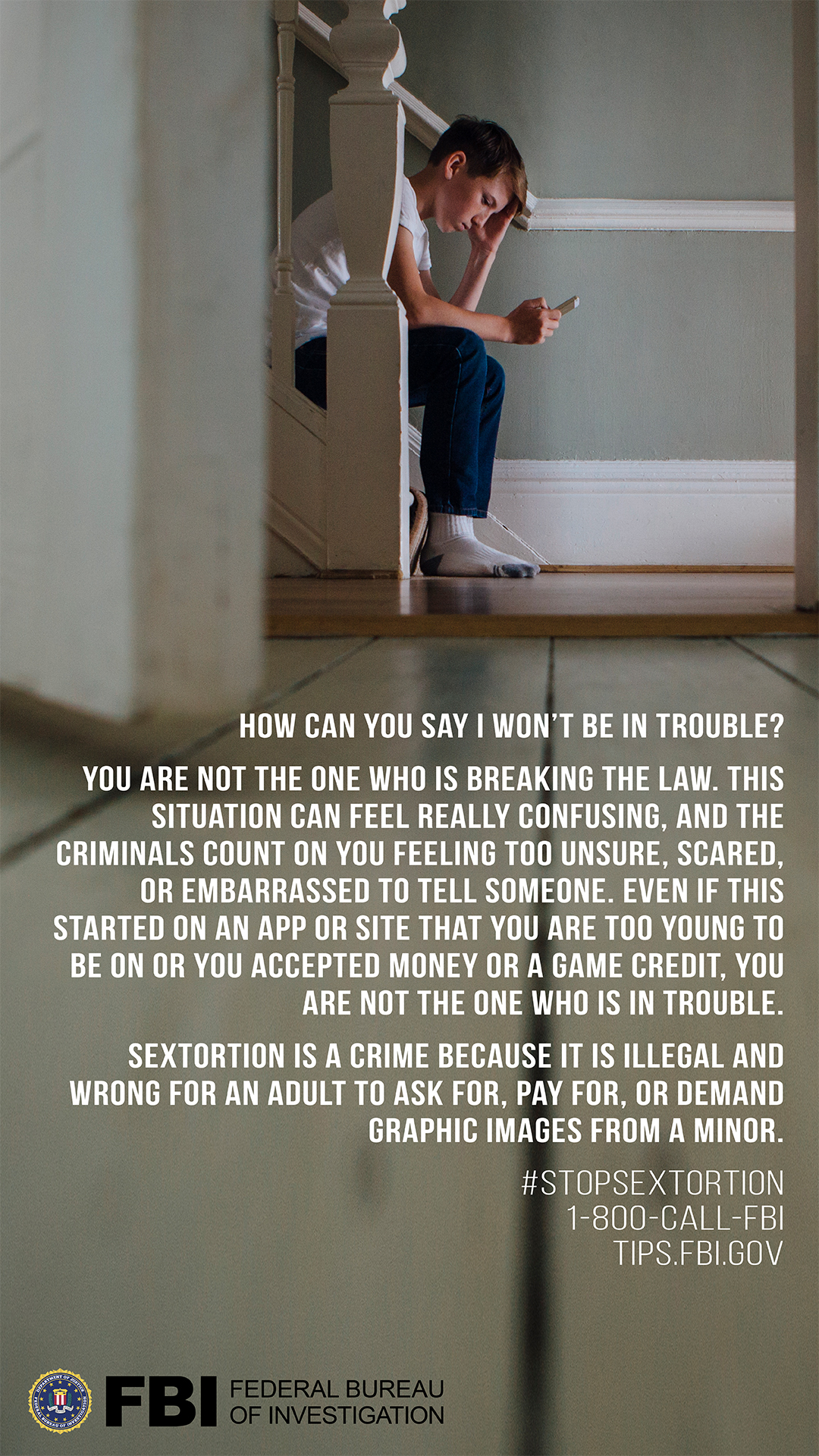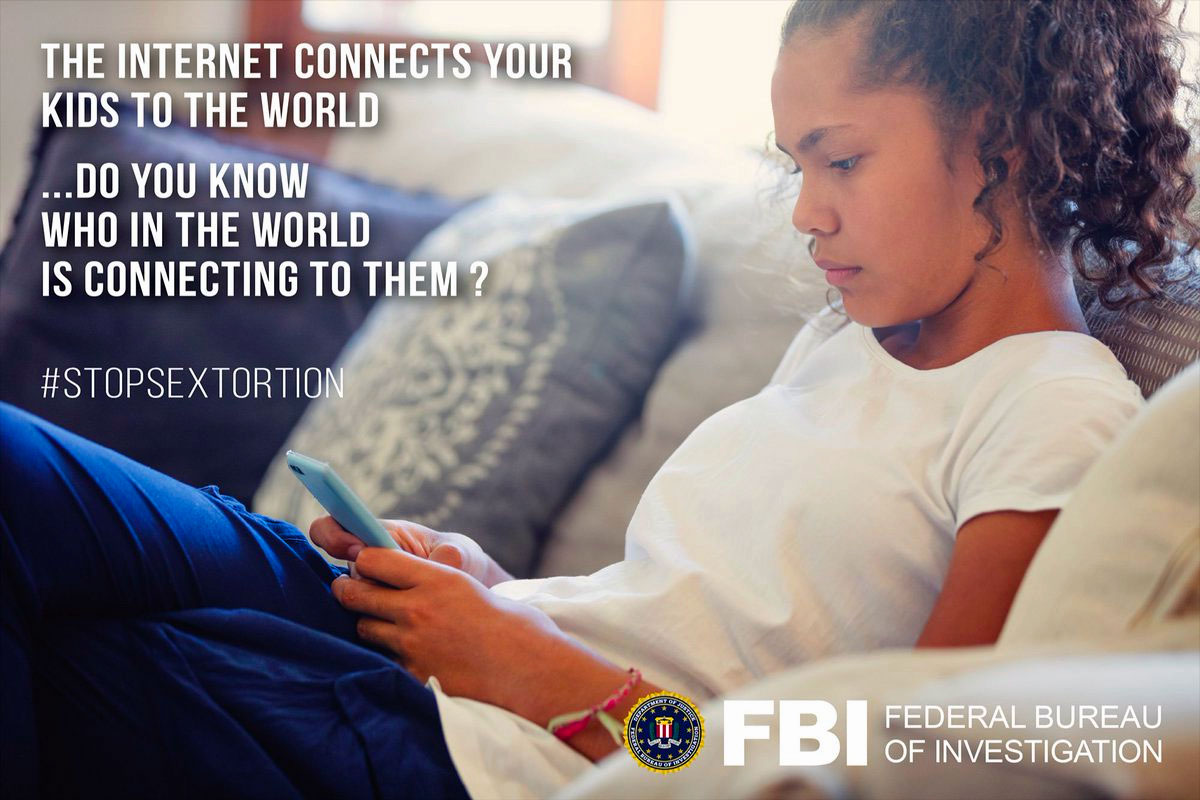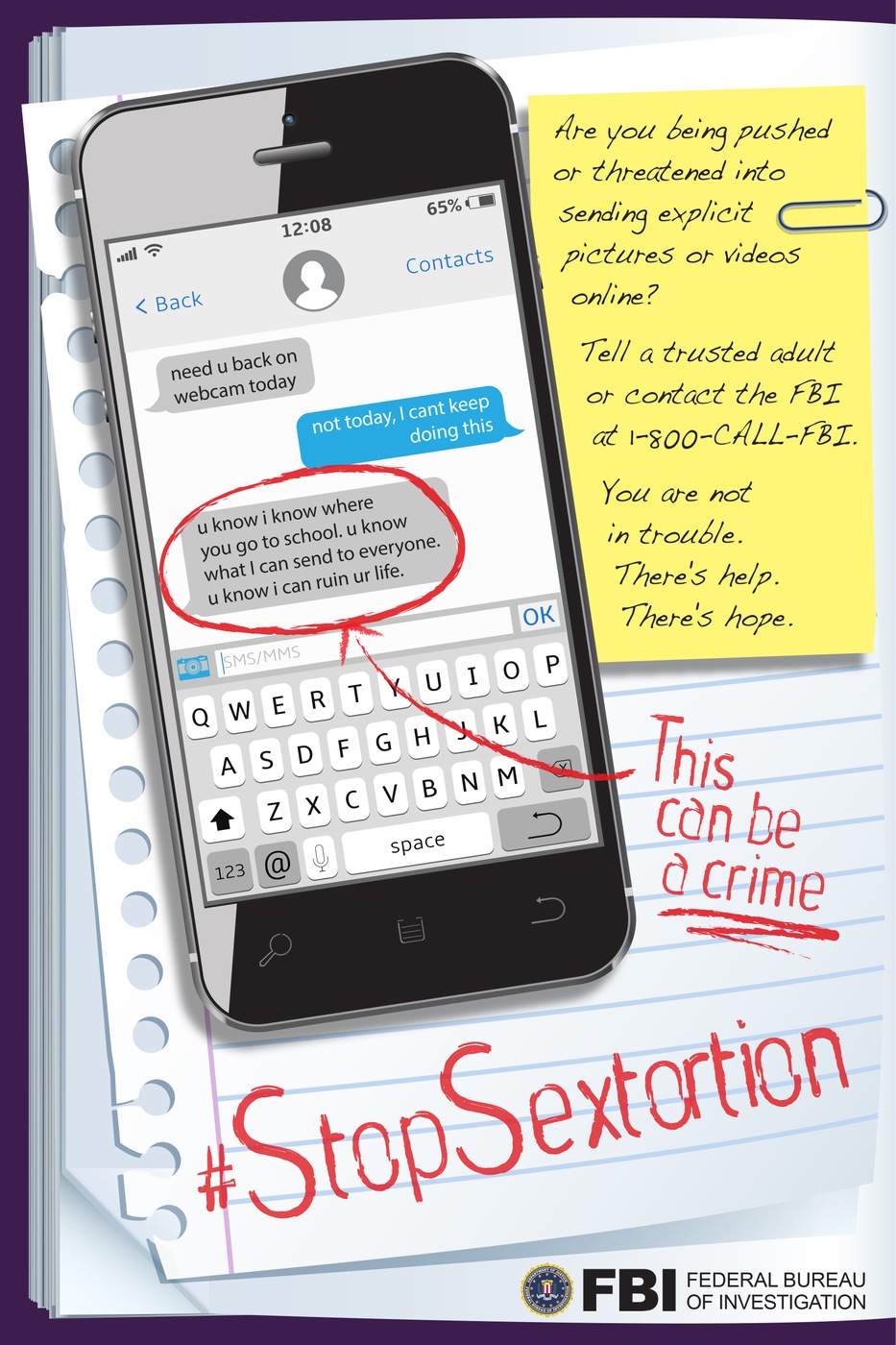
By the FBI
Youth Should Be On Guard Online
Students in many high schools and middle schools will soon be walking by FBI posters warning them of a crime that begins on their smartphones, computers, and game consoles.
“The goal of our Stop Sextortion campaign is to alert young people to one of the risks that they can encounter online,” said Supervisory Special Agent Brian Herrick, assistant chief of the FBI’s Violent Crime Section.
“Both youth and caregivers need to understand that a sexual predator can victimize children or teens in their own homes through the devices they use for gaming, homework, and communicating with friends.”
Sextortion begins when a predator reaches out to a young person over a game, app, or social media account.
Through deception, manipulation, money and gifts, or threats, the predator convinces the young person to produce an explicit video or image.
When the young person starts to resist requests to make more images, the criminal will use threats of harm or exposure of the early images to pressure the child to continue producing content.
“These predators are really good at targeting youth,” said Special Agent Kiffa Shirley in the FBI’s Billings Resident Agency in Montana (part of the Salt Lake City Field Office).
Shirley recently investigated a case where the criminal offered money in exchange for explicit images from teens.
That man, Tyler Daniel Emineth, was sentenced to 18 years in prison for his crimes.

“Young people don’t seem to have an on-guard mentality when it comes to strangers contacting them through the Internet,” said Shirley.
“And many teens feel less inhibited about sharing online.”
That sense of trust and comfort allows a criminal to coerce a young person into creating and sending an image, which begins the cycle of victimization.
The Stop Sextortion campaign seeks to inform students of the crime so they know how to avoid risky situations online and know to ask for help if they are being victimized.
Resources for Youth
What Kids and Teens Need to Know About Sextortion
What is sextortion?
Sextortion describes a crime that happens online when an adult convinces a person who is younger than 18 to share sexual pictures or perform sexual acts on a webcam.
How does it start?
Sextortion can start on any site where people meet and communicate. Someone may contact you while you are playing a game online or reach out over a dating app or one of your social media accounts.
In some cases, the first contact from the criminal will be a threat. The person may claim they already have a picture or video of you that they will share if you don’t send more pictures.
More often, however, this crime starts when young people believe they are communicating with someone their own age who is interested in a relationship or someone who is offering something of value.

The adult can use threats, gifts, money, flattery, lies, or other methods to get a young person to produce these images.
After the criminal has one or more videos or pictures, they use the threat of sharing or publishing that content to get the victim to produce more images.
The adult has committed a crime as soon as they ask a young person for a single graphic image.
Why do young people agree to do this?
The people who commit this crime have studied how to reach and target children and teens.
One person the FBI put in prison for this crime was a man in his 40s who worked as a youth minister so he could learn how teens talked to each other.
Then, he created social media profiles where he pretended to be a teenage girl.
This “girl” would start talking to boys online and encourage them to make videos.
Another person offered money and new smartphones to his victims.
In one case, the criminal threatened a girl—saying he would hurt her and bomb her school—if she didn’t send pictures.
Other cases start with the offer of currency or credits in a video game in exchange for a quick picture.
How do you know who can be trusted online?
That’s what is so hard about online connections.
The FBI has found that those who commit this crime may have dozens of different online accounts and profiles and are communicating with many young people at the same time—trying to find victims.
Be extremely cautious when you are speaking with someone online who you have not met in real life.

It’s easy to think: I’m on my phone, in my own house, what could possibly happen?
But you can very quickly give a criminal the information and material he needs to do you harm.
But how can this harm me?
It’s true that these criminals don’t usually meet up with kids in real life, but the victims of this crime still experience negative effects. The criminals can become vicious and non-stop with their demands, harassment, and threats.
Victims report feeling scared, alone, embarrassed, anxious, and desperate. Many feel like there’s no way out of the situation.
What do I do if this is happening to me?
If you are ready, reach out to the FBI at 1-800-CALL-FBI or report the crime online at tips.fbi.gov. Their agents see these cases a lot and have helped thousands of young people.
Our goals are to stop the harassment, arrest the person behind the crime, and help you get the support you need.
If you’re not feeling ready to speak to the FBI, go to another trusted adult. Tell them you are being victimized online and need help.
Talking about this can feel impossible, but there are people who can help. You are not the one in trouble.
How can you say I won’t be in trouble?
You are not the one who is breaking the law.
This situation can feel really confusing, and the criminals count on you feeling too unsure, scared, or embarrassed to tell someone.
Even if this started on an app or site that you are too young to be on. Even if you felt okay about making some of the content.
Even if you accepted money or a game credit or something else, you are not the one who is in trouble.
Sextortion is a crime because it is illegal and wrong for an adult to ask for, pay for, or demand graphic images from a minor.

How can I help someone else who is in this situation?
If you learn a friend, classmate, or family member is being victimized, listen to them with kindness and understanding.
Tell them you are sorry that this is happening to them and that you want to help.
Let them know that they are the victim of a crime and have not done anything wrong.
Encourage them to ask for help and see if you can help them identify a trusted adult to tell.
How do I protect myself and my friends?
Your generation can be the generation that shuts down these criminals.
Awareness and sensible safety practices online, along with a willingness to ask for help, can put an end to this exploitation.
The FBI agents who work on these cases want you to know these six things:
-
Be selective about what you share online. If your social media accounts are open to everyone, a predator may be able to figure out a lot of information about you.
-
Be wary of anyone you encounter for the first time online. Block or ignore messages from strangers.
-
Be aware that people can pretend to be anything or anyone online. Videos and photos are not proof that a person is who they claim to be. Images can be altered or stolen.
-
Be suspicious if you meet someone on one game or app and they ask you to start talking to them on a different platform.
-
Be in the know. Any content you create online—whether it is a text message, photo, or video—can be made public. And once you send something, you don’t have any control over where it goes next.
-
Be willing to ask for help. If you are getting messages or requests online that don’t seem right, block the sender, report the behavior to the site administrator, or go to an adult. If you have been victimized online, tell someone.
(An FBI special agent defines sextortion and provides tips to avoid falling prey to online predators. Courtesy of the FBI – Federal Bureau of Investigation and YouTube.)
Dangerous Connections
Youth Face a Risk of Sextortion Online
One victim was a 14-year-old boy from West Virginia. Another victim from Michigan was only 12.
Yet another was a 17-year-old girl from Ohio who attempted suicide in a desperate try to escape the situation.
In total, the FBI was able to identify 20 young people who were harassed, threatened, and sexually exploited online by an Indiana man who had served as a youth minister in his community.

When the FBI arrested Richard Finkbiner in April 2012, the 40-year-old had more than 22,000 videos of webcam feeds, much of it sexually explicit content that he had obtained from young people nationwide.
Investigators believe he had dozens more victims that they could not identify, perhaps hundreds more.
The Finkbiner case is one in a long list of sextortion cases that have been investigated or prosecuted in the last two decades.
FBI agents say more and more cases cross their desks each year involving young people who are manipulated, threatened, or coerced into creating explicit or pornographic content by an adult online.
(Ashley Reynolds was 14 when she was victimized by an online predator in 2009. Courtesy of the FBI – Federal Bureau of Investigation and YouTube.)
The perpetrators employ gaming platforms, social media, and dating and video chat applications to reach their young victims and use any number of ploys—from pretending to be a romantic interest, flattery and attention, offers of money or other items of value, or threats to coerce the child to produce an explicit image.
Once the perpetrator has a single image or video, they will use threats of exposure or other means of coercion to make the child produce more and more images and even more explicit material.
“The second the criminal gets a picture, that child’s life is going to be turned upside down,” said Special Agent Ryan Barrett, who worked on Finkbiner’s case from the FBI’s Indianapolis Field Office.
“These people are relentless. They don’t care.”
Finkbiner sent his victims doctored but believable screenshots of their videos on pornographic websites when they refused to comply with his next demand; he also sent lists of friends and family taken from the young people’s social media accounts with threats to widely share their material.
Seeing some of the messages Finkbiner sent his victims can help make clear how threatening and brutal these perpetrators can be:
“I wont get caught im a hacker i covered my tracks.”
“If u don’t play i promise ill f*** your life over.”
Although in most sextortion cases there is no hands-on abuse, the offense is serious, the sentences for offenders are long (50 years in the Finkbiner case), and the impact on a child’s life severe.
Catherine Connell, a licensed social worker and child/adolescent forensic interviewer and program manager with the FBI, says she sees a number of damaging effects from the crime among the victims she works with, including depression, anxiety, hopelessness, fear, and suicidal thoughts.
“The trauma level we see with these kids is significant,” said Connell.
To understand how and why young people become victims, it helps to understand the mind of a young person and the techniques used by the criminals.
First, this crime is happening where young people usually feel most comfortable—in their own homes, connected to a device or a game that feels familiar and safe.

“It’s important for both parents and children to realize that their guard is typically down when they’re engaging with their device,” said Supervisory Special Agent Brian Herrick, assistant chief of the FBI’s Violent Crime Section.
Second, young people are not adults. Connell stressed that however smart or mature a teen may seem, his or her brain is not fully formed.
As they ride through what she calls a perfect storm of social, emotional, sexual, and cognitive development, they are making imperfect decisions.
“Your teens are facing decisions with more emotion and less cognitive thinking and judgement,” she said.
“They are not thinking, ‘If I do this, this is what may happen, this could be a consequence.’ ”
Finally, young people are up against criminals who have spent a great deal of time and energy learning how to target them.
In the Finkbiner case, he used a fake profile of an older teen girl to start a conversation with adolescent and teen boys.
He would then stream sexual images he had captured of a female victim and encourage the boy to send pictures or go on a webcam.

In a Portland case involving a 50-year-old perpetrator named David Ernest Otto, he found girls on a photo-sharing site who were open to the flattery, interest, and attention of an older man.
He then convinced them to start sending sexually explicit material.
He received a 15-year sentence in April 2019 for victimizing six minors.
In another case, a California man who is still awaiting trial threatened to kill, kidnap, and injure his victims to compel them to create content.
His bomb threats to a teenage girl in Plainfield, Indiana, even caused police to shut down several schools and stores in 2015.
Herrick also says the FBI is seeing an increasing number of cases start on connected gaming systems, where the competition is intense and the offer of game credits or codes is enough to convince a child to create an explicit image.
Whatever technique pushes the young person to produce the first image, fear, coercion, and manipulation keep the crime going.
In addition to the threats and coercion of the criminal, young victims often feel that they have done something wrong and will be punished by parents or caregivers or prosecuted by law enforcement if their actions are discovered.

Connell also stresses that as silly as it may seem to adults, the fear of being discovered and losing access to the technology that feels like a vital part of their lives is a serious concern.
“The number one thing is they feel like they’re going to tell mom and dad and their technology will be taken away and they’re going to get in trouble,” said Connell.
She also stressed that when the child knows there is photo and video evidence of their abuse, it makes it even harder to talk about.
The FBI agents and forensic interviewers who deal with this crime shared that if a child admits that they are experiencing this type of coercion, parents, educators, and caregivers should move first to help the child and try hard to put aside any anger or desire to punish.
“Your child’s bravest moment may be the moment they tell,” said Special Agent Damon Bateson, who worked on the Otto case and is dealing with other sextortion investigations in the FBI’s Portland Field Office.
“You want to be your kid’s best advocate,” Bateson stressed.
“Have those conversations so that if something does happen, your child comes to you for help.”
“The last thing you want is someone from the FBI knocking on your door because your child has been victimized in a crime.”
“It’s important from the youngest age, when your child first starts using the Internet, that you have those open dialogue conversations about what’s appropriate,” said Herrick.
Parents and caregivers should make decisions for their family about screen-time rules and limits.

Connell does feel regular spot checks and conversations about who your child is conversing with and what applications they are using can be important, but the nature of these ever smaller, ever more powerful, and ever present devices mean children will have many unguarded and unsupervised moments online.
Barrett said that after dealing with many of these cases, he feels the most important messages to young people are simple ones:
-
Many people online are not who they say they are.
-
Don’t talk to people you don’t know online.
-
Understand that any content produced on a web-enabled device can be made public.
-
If you are being threatened or coerced online, tell someone. There is help and there is hope.
To report suspected sextortion, call the nearest FBI field office or 1-800-CALL-FBI (225-5324).
To make a CyberTipline Report with the National Center for Missing & Exploited Children (NCMEC), visit report.cybertip.org.
(Jacksonville FBI Special Agent Larry Meyer discusses the case of Lucas Chansler. In November, 2015, Lucas Michael Chansler was sentenced to 105 years in prison after he pleaded guilty to nine counts of producing child pornography. Prosecutors say Chansler, formerly of St. Johns, Florida, communicated with hundreds of teen girls in 26 states, three Canadian provinces, and the United Kingdom. Authorities have identified 109 victims, but believe there are about 240 more. Courtesy of the FBI – Federal Bureau of Investigation and YouTube.)
Resources for Parents
What is sextortion?
Sextortion occurs when an adult, through threat or manipulation, coerces a minor into producing a sexually explicit image and sending it over the Internet.
Why would any child or teen agree to do such a thing?
The individuals carrying out this crime are skilled and ruthless and have honed their techniques and approaches to maximize their chances at success.
The entry point to a young person can be any number of mobile or online sites, applications, or games. The approach may come as compliments or flattery or the pretense of beginning a romantic relationship.
Another entry point is to offer the child something they value in exchange for a taking a quick picture.
This could be the possibility of a modeling contract; online game credits or codes; or money, cryptocurrency, and gift cards.
The third common point of entry is to go right to threats by either claiming they already have an image of the young person that they will distribute or threatening to harm the child or other people or things the child cares about.
Once the perpetrator has the first image, they use the threat of exposure or other harm to keep the child producing more and more explicit material.
But my child would never do that.
The FBI has interviewed victims as young as 8, and the crime affects children of both genders and crosses all ethnic and socioeconomic groups.
The victims are honor-roll students, the children of teachers, student athletes, etc. The only common trait among victims is Internet access.
Why don’t the victims tell someone or ask for help?

The cycle of victimization continues because the child is afraid—afraid of the repercussions threatened by the criminal and afraid they will be in trouble with their parents, guardians, or law enforcement.
By the time a child is a victim, they have done something that may be generating deep feelings of shame and embarrassment.
The criminal may also be telling them they have produced child pornography and will be prosecuted for it.
In addition, they may fear their access to their phone or computer will be taken away from them as a result of their actions.
How do I protect the young people I know?
Information-sharing and open lines of communication are the best defense. Young people need to know this crime is happening and understand where the risks are hiding.
Explain to the children in your life that people can pretend to be anyone or anything online, a stranger reaching out to them online may be doing so with bad intent, and no matter what the platform or application claims, nothing “disappears” online.
If they take a photo or video, it always has the potential to become public.
You may choose to place certain limits on your children’s Internet use or spot check their phones and other devices to see what applications they are using and with whom they are communicating.
This can be part of an open and ongoing conversation about what it and is not appropriate online. It also may be worth considering a rule against devices in bedrooms overnight or shutting off Wi-Fi access in the overnight hours.
Caregivers may also want to review the settings on a young person’s social media accounts with them. Keeping accounts private can prevent predators from gathering their personal information.
The other crucial element is to keep the door open to your children so that they know they can come to you and ask for help.
Let them know that your first move will be to help—always.
These predators are powerful because of fear, and the victims suffer ever more negative consequences as the crime carries on over days, weeks, and months.
If you are the adult a child trusts with this information, comfort them, help them understand they have been the victim of a crime, and help them report it to law enforcement.

How to Talk About Sextortion with Your Kids: Three 30-Second Conversations
The New Version of Don’t Talk to Strangers
-
When you’re online, has anyone you don’t know ever tried to contact or talk to you?
-
What did you do or what would you do if that happened?
-
Why do you think someone would want to reach a kid online?
-
You know, it’s easy to pretend to be someone you’re not online and not every person is a good person. Make sure you block or ignore anything that comes in from someone you don’t know in real life.
The Power of a Picture
-
Has anyone you know ever sent a picture of themselves that got passed around school or a team or club?
-
What’s possible anytime you send someone a picture?
-
What if that picture were embarrassing?
-
Can you think about how someone could use that kind of picture against a person?
I’m Here to Help
-
I read an article today about kids being pressured to send images and video of their bodies to a person they met online. Have you ever heard about anything like that?
-
Sometimes they were being threatened and harassed—scary stuff.
-
You know, if you are ever feeling like something is going on—online or off—that feels scary or wrong or over your head, my first concern is going to be helping you. You can always come to me.
Additional Information
- FBI Video: Victim of Sextortion Speaks Out
- NCMEC NetSmartz (Online Safety Tool)
- NCMEC NetSmartz Video: Are You Sure You Know Who You’re Talking to Online?
- FBI Safe Online Surfing | En Español
- NCMEC – The Issues: Sextortion
- FBI, This Week Podcast: Report Sextortion
- FBI, This Week Podcast: Sextortion Activity on the Rise
- Esta Semana el en FBI Podcast: Sextorsión
- FBI Video: What is Sextortion?
- FBI Violent Crimes Against Children/Online Predators Page
- FBI Story (1/26/18): Online Predator Used Familiar Tactics to Victimize 12-Year-Old Girl
- FBI Story (2/5/13): Sextortion Cons Target Minors
Original post https://www.fbi.gov/news/stories/stop-sextortion-youth-face-risk-online-090319
FBI Honored in the 2018 ‘ASTORS’ Homeland Security Awards Program
Federal Bureau of Investigation (FBI)
-
‘Excellence in Homeland Security’
-
Violent Crimes against Children (VCAC) program
The Annual ‘ASTORS’ Awards Program is specifically designed to honor distinguished government and vendor solutions that deliver enhanced value, benefit and intelligence to end users in a variety of government, homeland security and public safety vertical markets.

The 2018 ‘ASTORS’ Awards Program drew an overwhelming response from industry leaders with a record high number of corporate and government nominations received, as well as record breaking ‘ASTORS’ Presentation Luncheon Attendees, with top firms trying to register for the exclusive high – end luncheon and networking opportunity – right up to the event kickoff on Wednesday afternoon, at the ISC East registration!
Over 130 distinguished guests representing National, State and Local Governments, and Industry Leading Corporate Firms, gathered from across North America, Europe and the Middle East to be honored among their peers in their respective fields which included:
- The Department of Homeland Security
- The Federal Protective Service (FPS)
- Argonne National Laboratory
- The Department of Homeland Security
- The Department of Justice
- The Security Exchange Commission Office of Personnel Management
- U.S. Customs and Border Protection
- Viasat, Hanwha Techwin, Lenel, Konica Minolta Business Solutions, Verint, Canon U.S.A., BriefCam, Pivot3, Milestone Systems, Allied Universal, Ameristar Perimeter Security and More!
The Annual ‘ASTORS’ Awards is the preeminent U.S. Homeland Security Awards Program highlighting the most cutting-edge and forward-thinking security solutions coming onto the market today, to ensure our readers have the information they need to stay ahead of the competition, and keep our Nation safe – one facility, street, and city at a time.
The 2019 ‘ASTORS’ Homeland Security Awards Program is Proudly Sponsored by ATI Systems, Attivo Networks, Automatic Systems, and Desktop Alert.
Final Nominations are now being accepted for the 2019 ‘ASTORS’ Homeland Security Awards at https://americansecuritytoday.com/ast-awards/.
Comprehensive List of Categories Include:
| Access Control/ Identification | Personal/Protective Equipment | Law Enforcement Counter Terrorism |
| Perimeter Barrier/ Deterrent System | Interagency Interdiction Operation | Cloud Computing/Storage Solution |
| Facial/IRIS Recognition | Body Worn Video Product | Cyber Security |
| Video Surveillance/VMS | Mobile Technology | Anti-Malware |
| Audio Analytics | Disaster Preparedness | ID Management |
| Thermal/Infrared Camera | Mass Notification System | Fire & Safety |
| Metal/Weapon Detection | Rescue Operations | Critical Infrastructure |
| License Plate Recognition | Detection Products | And Many Others! |
Don’t see a Direct Hit for your Product, Agency or Organization?
Submit your category recommendation for consideration to Michael Madsen, AST Publisher at: mmadsen@americansecuritytoday.com.
2018 Champions Edition
 See the 2018 ‘ASTORS’ Champions Edition – ‘Best Products of 2018 ‘ Year in Review’ for in-depth coverage of the outstanding products and services of firms receiving American Security Today’s 2018‘ASTORS’ Homeland Security Awards.’
See the 2018 ‘ASTORS’ Champions Edition – ‘Best Products of 2018 ‘ Year in Review’ for in-depth coverage of the outstanding products and services of firms receiving American Security Today’s 2018‘ASTORS’ Homeland Security Awards.’
Enter Early to Maximize Media Coverage of your Products and Services at Kickoff, and Get the Recognition Your Organization Deserves!
And be sure to Register Early for the 2019 ‘ASTORS’ Awards Presentation Luncheon at ISC East 2019 to ensure your place at this limited- space event!

2018 ‘ASTORS’ Homeland Security Awards Luncheon at ISC East
2018 Government Excellence Award Winners in the ‘ASTORS’ Homeland Security Awards Program
The following Government Agencies were recognized in the 2018 ‘ASTORS’ Homeland Security Awards:
-
Argonne National Laboratory, Modified Infrastructure Survey Tool (MIST)
-
Defense Advanced Research Projects Agency – DARPA, Subterranean (SubT) Challenge
(Learn About the DARPA Subterranean Challenge working with multidisciplinary teams from around the world to compete in the development of the autonomy, perception, networking, and mobility technologies necessary to map explore and search underground networks in unpredictable conditions. Courtesy of DARPAtv and YouTube.)
-
Department of Justice (DOJ) Bureau of Justice Assistance (BJA), Project Safe Childhood
-
Department of Justice (DOJ) Bureau of Justice Assistance (BJA), Project Safe Neighborhoods Program
-
Department of Justice (DOJ) Securities Exchange Commission (SEC) Office of Personnel Management, Federal Risk Mgmt Process Training (FedRMPTP)
-
DHS Federal Protective Service, Modified Infrastructure Survey Tool (MIST)
-
DHS Science and Technology Directorate (S&T), Android Team Awareness Kit (ATAK)
(The Android Team Awareness Kit (ATAK) is a gps communications tool that runs on a mobile device. It improves situational awareness by allowing users to know where their mission partners are located, regardless of affiliation, improves communications through a variety of applications and was successfully used in 2017 Hurricane operations in Houston and Puerto Rico. Courtesy of the DHS Science and Technology Directorate and YouTube.)
-
DHS Science and Technology Directorate (S&T), Enhanced Dynamic Geo-Social Environ (EDGE) Virtual Online Training for First Responders
(DHS S&T’s Enhanced Dynamic Geo-Social Environment (EDGE) virtual training platform provides a safe, immersive environment where first responders, and now educators, can hone their skills and prepare for a multitude of incident responses. Built on the same video gaming platforms as popular titles like Fortnite, EDGE was intentionally designed to be easily accessed, easily used, and easily integrated into agencies’ existing training protocols. Courtesy of the DHS Science and Technology Directorate and YouTube.)
-
DHS Science and Technology Directorate (S&T), Flood Apex Program Flood Sensors
-
Federal Bureau of Investigation (FBI),Violent Crimes against Children (VCAC) program
(Learn About the FBI VCAC Program, and hear from Special Agent Danielle Messineo, who works in the Crimes Against Children division, trying to prevent future victims by giving presentations to schoolchildren. Courtesy of USA Network and YouTube.)
-
International Association of Counterterrorism and Security Professionals (IACP), IACSP Training and Technology
-
Joint Interagency Task Force South (JIATF-S), United States Multi-Service, Multi-Agency Task Force
-
Pentagon Force Protection Agency, Detection & Emergency Response to envelopes containing the deadly poison ricin at a Pentagon mail screening facility
(Learn About the Joint Interagency Task Force South on Key West, Florida, a multi-agency, international alliance whose mission is to cover 42 million square miles of territory primarily in Central and South America to stem the flow of illegal drugs and to disrupt and dismantle sophisticated narco-trafficking networks. Much of that work is carried out on the high seas. Courtesy of Doug Brumbaugh and YouTube.)
-
U.S. Customs and Border Protection, CBP Entry/Exit Program
-
US Immigration and Customs Enforcement’s (ICE) Homeland Security Investigations (HSI), Human Rights Violators and War Crimes Unit (HRVWCU)
(U.S. Immigration and Customs Enforcement’s (ICE) Homeland Security Investigations (HSI) operates the Human Rights Violators and War Crimes Unit (HRVWCU) within the National Security Investigations Division (NSID). Preceded by the U.S. Immigration and Naturalization Service, HSI has more than 30 years of experience in successfully investigating human rights violators. The unit conducts investigations focused on human rights violations in an effort to prevent the United States from becoming a safe haven to those individuals who engage in the commission of war crimes, genocide, torture and other forms of serious human rights abuses from conflicts around the globe. When foreign war crimes suspects, persecutors and human rights abusers are identified within U.S. borders, the unit utilizes its powers and authorities to the fullest extent of the law to investigate, prosecute and, whenever possible, remove any such offenders from the United States. Courtesy of ICE and YouTube.)
Individuals Recognized for ‘Excellence in Homeland Security’ in the 2018 ‘ASTORS’ Awards Program are as follows:
-
Edward Reinhold, Deputy Assistant Director, FBI (Ret)
-
Joel McNelly, Charlotte-Mecklenburg Police Department
-
Matt Quillen, Bristol Virginia Police Department
-
Stanley I. White, Counterintelligence Advisor, the International Association for Counterrorism & Security Professionals (IACSP)
-
Thomas Homan, Acting Director, U.S. Immigration and Customs Enforcement (ICE) (Ret)
-
Thomas O’Connor, President of the FBI Agents Association
2019 ‘ASTORS’ Homeland Security Awards Program Industry Experts Include
Ameristar Perimeter Security, ATI Systems (Acoustic Technology Inc.), Attivo Networks, BriefCam, Canon U.S.A., Entrust Datacard, FLIR Systems, Hanwha Techwin, HID Global,
ISS – Intelligent Security Systems, Ivanti, Konica Minolta Business Solutions, Milestone Systems, Lenel, LRAD Corporation, Milestone Systems,
Orolia, NICE, Pivot3, Rave Mobile Safety, Royal Holdings, Senstar Corporation, Smiths Detection, SolarWinds, Verint, Viasat, and More!
For a complete list of award winners, click here.
2019 ‘ASTORS’ Awards Presentation Luncheon

The highlight of the 2019 ‘ASTORS’ Homeland Security Awards Program will be the Awards Presentation Luncheon at ISC East at the Javits Convention Center on Wednesday, November 20, 2019.
AST focuses on New and Evolving Security Threats at All Levels of Homeland Security and Public Safety for personnel who are on the front lines of protecting our communities, cities and nation.
AST reaches both the private and public experts, essential to meeting today’s growing security challenges.

For Luncheon Sponsorship Opportunities and More, please contact Michael Madsen, AST Publisher at: mmadsen@americansecuritytoday.com or call 732.233.8119 (mobile) or 646-450-6027 (office).
Proud Sponsors of the 2019 ‘ASTORS’ Homeland Security Awards Program include ATI Systems, Attivo Networks, Automatic Systems, and Desktop Alert.

Be sure to Register Early for the 2019 ‘ASTORS’ Awards Presentation Luncheon at ISC East 2019 to ensure your place at this limited- space event!
Why American Security Today?
American Security Today is uniquely focused on the broader Homeland Security & Public Safety marketplace with over 75,000 readers at the Federal, State and local levels of government as well as firms allied to government.
The old traditional security marketplace has been covered by a host of security publications that have changed little over many years.
American Security Today brings forward a fresh compelling look and read with our customized digital publications that provides our readers with solutions to their challenges.
Our Editorial staff provides a full plate of topics for our AST monthly digital editions, AST Website and AST Daily News Alerts.
‘PROTECTING OUR NATION, ONE CITY AT A TIME’

The editorial calendar and AST’s high drawing website features 23 different Technology and Marketing Sectors such as Access Control, Perimeter Protection, Video Surveillance/Analytics, Airport Security, Border Security, CBRNE Detection, Border Security, Ports, Cybersecurity, Networking Security, Encryption, Law Enforcement, First Responders, Campus Security, Security Services, Corporate Facilities and Emergency Response among others.
AST has Expanded readership into vital Critical Infrastructure audiences such as Protection of Nuclear Facilities, Water Plants & Dams, Bridges & Tunnels, and other Potential targets of terrorism.
These sectors are part of the new integration, where these major applications communicate with one another in a variety of solutions to protect our cities and critical infrastructure.
Other areas of concern include Transportation Hubs, Public Assemblies, Government Facilities, Sporting & Concert Stadiums, our Nation’s Schools & Universities, and Commercial Business Destinations – enticing targets for extremist or lone wolf attacks due to the large number of persons and resources clustered together.
AST strives to meet a 3 STAR trustworthiness rating, based on the following criteria:
- Provides named sources
- Reported by more than one notable outlet
- Includes supporting video, direct statements, or photos



























